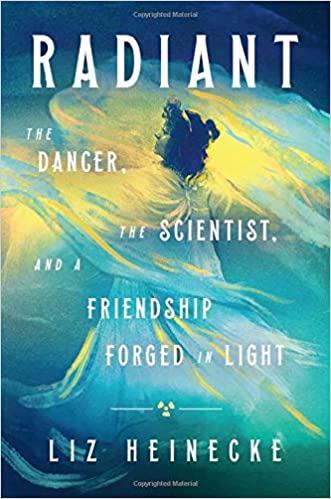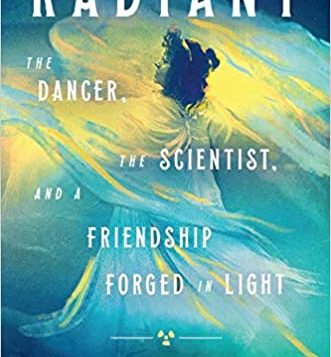 RADIANT
RADIANT
The Dancer, the Scientist, and a Friendship Forged in Light
by Liz Heinecke
Grand Central Publishing
336 pages, $28.
ONE AUTUMN DAY in my grammar-school years, a trip to the shoe store delivered a surprise: the chance to set my feet into the bottom of a contraption to gauge how well the new shoes fit. Using an eyepiece on the machine’s top, I could see inside my foot. This was the 1950s, and the experience was titillating. By the following fall, peering at foot bones was off limits, as word spread about the dangers of X-rays.
This memory surfaced as I read Radiant, Liz Heinecke’s lively narrative about the connections between scientist Marie Curie and dancer-choreographer Loïe Fuller in Paris at the turn of the 20th century. The Minnesota author’s background in molecular biology and her online teaching about scientific experimentation equip her to tell this story with clarity and enthusiasm. The book amplifies earlier biographies by homing in on each woman’s work process.
Radiant opens with Fuller’s arrival in Paris in 1892 and closes with Curie’s death in 1934. Each was an outsider in France. Maria Skłodowska, born in Krakow in 1867, left home in her twenties to study mathematics, physics, and chemistry at the Sorbonne, and she became the first woman to earn a PhD there. Building on Henri Becquerel’s discovery of the phosphorescence of uranium and working with her husband Pierre, she confirmed radium and polonium as atomic elements. For this achievement she and Pierre shared a 1903 Nobel Prize in physics with Becquerel. Curie was the first woman so honored, and in 1911 she became the first person to receive the prize twice, this time in chemistry.
Marie Louise Fuller, later known as Loïe, was born near Chicago in 1862. Daughter of a popular fiddler who was himself a graceful dancer, she acted in vaudeville until the age of thirty, when she moved to Paris. Capitalizing on Parisians’ fascination with light, Fuller mesmerized audiences at the Folies Bergère with her original illuminated dances, and she became a sensation. An enraptured, shy young admirer, Gabrielle (“Gab”) Bloch, pursued the dancer and they eventually moved in together, openly and for good. Gab ran the business side of Fuller’s work, and she would manage the dance troupe after her partner’s death. At age 52, Fuller was nowhere near done, dancing atop the Eiffel Tower at 3 a.m. to celebrate the spring solstice.

Heinecke telescopes their lives so as to explain how her two subjects did their work and how their lives dovetailed. Curie spoke at the Inaugural Congress of Physics, for example, which was held in conjunction with the 1900 Paris Exposition at which Fuller danced.
Curie toiled for years over pots of pitchblende, a faintly radioactive residue of uranium mining, and in her address to the world’s top physicists she laid claim to astonishing findings. “[T]he crowd of scientists sat spellbound in the stifling room watching Marie demonstrate her method for measuring radioactivity, using delicate equipment she’d transported from [the]lab,” Heinecke reports. “Her meticulous measurements had demonstrated that the power of the rays coming from each radioactive element depended solely on the quantity of the element being measured. The bigger the sample, the higher the reading on her electrometer.” Since they didn’t cause changes to the element itself, Curie concluded that the rays, which she termed “radioactivity,” were an atomic property. From seven tons of pitchblende she extracted a one-decigram sample of pure radium chloride, smaller than a grain of rice but enough to determine its atomic weight. Even as her fingers became cracked with scars and her hands unsteady, she continued to work, hoping the results would be useful for humanity. Curie would die at 66 from aplastic pernicious anemia, a condition caused by exposure to radiation.
Work was an obsession for Fuller too. Short and plump, she created the onstage illusion of a sylph-like creature whose dips and swirls evoked such natural phenomena as a butterfly, a lily, or fire. To do this she draped her body in perhaps a hundred yards of gauze-like fabric, lengthening her reach with wooden or aluminum rods. Her dances were first illuminated by gas footlights and then by electric spotlights beamed through rotating translucent colored disks, suggesting flames, for example, with red, orange, or yellow light. A glass square was inset into the stage to allow lighting from below, and “La Loïe” held exacting rehearsals.
In a 200-seat theater built expressly for Fuller on Exposition grounds, audiences, in Heinecke’s words, “went crazy for her Lily Dance as her long wands threw impossible volumes of silk twenty feet into the air to create a spinning white vortex that concealed her figure completely in a funnel of fabric.” Commented French critic Jean Lorrain of her “Fire Dance”: “Loïe Fuller does not burn; she filters and oozes light, she herself is the flame.” Black-and-white photos in Radiant give a sense of these movements, as does the picture of her 1894 patent for a dancing costume. Fuller gave both matinée and evening performances on many days, and her tours included Europe, the U.S., and South America. The indefatigable performer would succumb to pneumonia at the age of 65 after decades of bronchial attacks and bouts of exhaustion.
Heinecke depicts Curie and Fuller not as close friends but as remarkable women who welcomed each other’s company. Fuller danced at the Curie home, for instance, and the scientist showed her the Curie laboratory at night, its glass jars of radium and polonium emanating soft blue light. A riveted Fuller imagined daubing her costumes with radioactive bits for a glow-in-the-dark effect, but Curie discouraged the idea, aware that radium could burn skin tissue. Curie socialized mainly with academics and family, but Fuller courted a wider circle, ranging from sculptor Auguste Rodin to astronomer Camille Flammarion, Queen Marie of Romania, and inventor Thomas Edison, who discussed electrical lighting for stage effects with Fuller when she toured his New Jersey lab.
Heinecke shows both women in committed relationships. Marie and Pierre are seen as a devoted couple, with Marie devastated by his early death from a wagon accident. Loïe and Gab come across as loyal and supportive partners, if not especially romantic ones, and direct evidence of their intimacy is thin, given the times. However, the dancer wrote postcards to Gab during their 1905 tour in Hanover, Germany, while they were staying at the same hotel but in separate rooms, and these survive. Heinecke alludes to them as “funny postcards,” but an earlier biography quotes their words, which imply deep feeling, such as: “My life friend, dear Gab. Thy Loïe”; “Yours tenderly, my dear, strong girl, Gab. Loïe”; and “However we do get on so well together & I’m old & you’re young. It is so strange my dearest Kiddie. Loïe.”
Radiant offers a well-researched account of the scientific and creative processes of two driven experimenters who reached worldwide fame. Marie Curie helped inaugurate the atomic age, with unhappy as well as positive consequences. The institute she founded in Paris is now a research center focused on biophysics, cell biology, and oncology, with an affiliated hospital. Fuller’s impact likewise persists. One scholar finds “traces of her spirit” in dancer-choreographer Jody Sperling’s work, for example, and a documentary titled Obsessed with Light: the Genius of Loïe Fuller awaits release. In the meantime, a brief silent clip of the dancer filmed by Spanish director Segundo de Chomón in 1902 can be viewed online.
Rosemary Booth is a writer and photographer living in Cambridge, MA.






